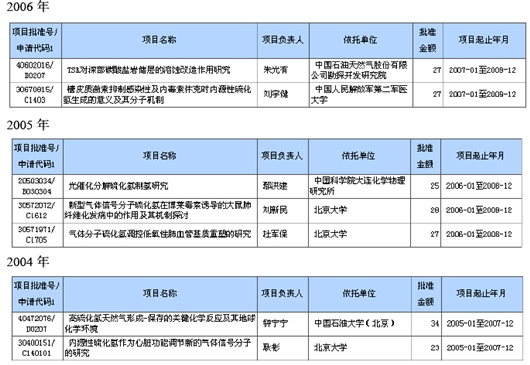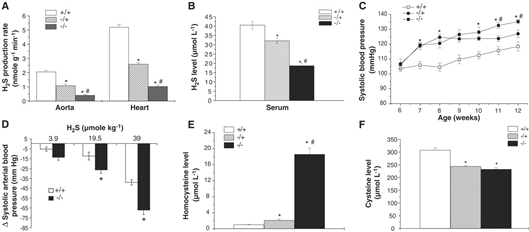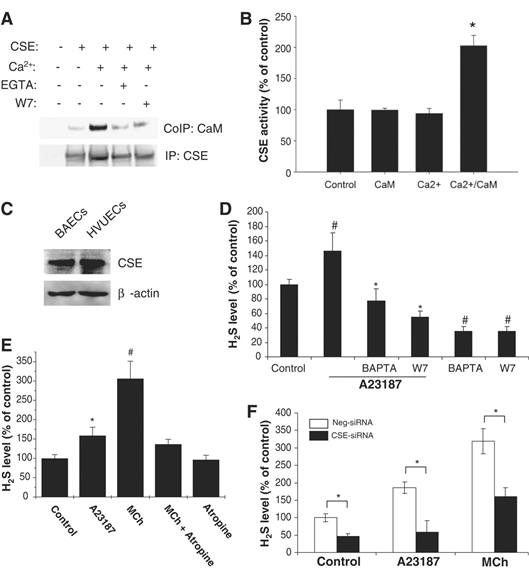博文
臭鸡蛋味的硫化氢:好香!
||
硫化氢(H2S)是一种无色气体,腐臭的鸡蛋发出的异味。目前很多文献证实该气体是继NO和CO之后的第三种内源性气体信号分子。最近,在10月24日出版的新一期《科学》(Science)杂志发表来来自美国约翰斯·霍普金斯大学和加拿大萨斯喀彻温大学、雷克海德大学的有关H2S调节血压的研究。该研究证实老鼠体内的硫化氢气体可以调节血压和血管功能,希望在这一研究成果基础上,将来利用硫化氢开发出治疗高血压的新方法(http://www.sciencemag.org.libproxy.usc.edu/cgi/content/full/322/5901/587)。
我一直很关注H2S的生理药理作用,今天看到该文在Science发表,让我百感交集。国内外目前对内源性硫化氢的生物学意义的研究已经成为一个新的研究热点,国内对内源性硫化氢的生物学意义的研究也很不错,北京大学唐朝枢教授的科研队伍发表了很多很好的文章。现就2002年来国家自然科学基金资助的有关H2S的课题列如下:



H2S as a Physiologic Vasorelaxant: Hypertension in Mice with Deletion of Cystathionine
Guangdong Yang,1,5 Lingyun Wu,2* Bo Jiang,1 Wei Yang,1 Jiansong Qi,1 Kun Cao,1 Qinghe Meng,3 Asif K. Mustafa,4 Weitong Mu,4,6 Shengming Zhang,5 Solomon H. Snyder,4* Rui Wang1,5*
Studies of nitric oxide over the past two decades have highlighted the fundamental importance of gaseous signaling molecules in biology and medicine. The physiological role of other gases such as carbon monoxide and hydrogen sulfide (H2S) is now receiving increasing attention. Here we show that H2S is physiologically generated by cystathionine
1 Department of Physiology,
2 Department of Pharmacology,
3 Department of Pathology,
4 Departments of Neuroscience, Pharmacology and Molecular Sciences and Psychiatry,
5 Department of Biology,
6 Department of Medicine, Gastroenterology Division,
* To whom correspondence should be addressed. E-mail: rwang@lakeheadu.ca (R.W.), lily.wu@usask.ca (L.W.), or ssnyder@jhmi.edu (S.H.S.).
Nitric oxide (NO) and carbon monoxide (CO) are established physiologic messenger molecules, and NO has an important role as an endothelial cell–derived relaxing factor (EDRF) and regulator of blood pressure (1, 2). Indirect evidence has implicated another endogenous gasotransmitter, hydrogen sulfide (H2S), in similar functions (3–7). H2S can be produced by cystathionine
To investigate the role of H2S as a physiologic vasorelaxant and determinant of blood pressure, we generated mice with a targeted deletion of the gene encoding CSE (8) (fig. S1, A to C). The homozygous (CSE–/–) and heterozygous (CSE–/+) mutant mice were viable, fertile, and indistinguishable from their control wild-type littermates (CSE+/+) in terms of growth pattern. CSE mRNA and protein were absent in heart, aorta, mesenteric artery, liver, and kidneys of CSE–/– mice (fig. S1, D and E). Endogenous H2S levels in aorta and heart of homozygous mutant male mice (CSE–/–) were both decreased by about 80% (Fig. 1A), and H2S levels in aorta and heart of heterozygous mutant male mice (CSE–/+) were both decreased by about 50%. Serum H2S levels in CSE–/– mice and CSE–/+ mice were reduced by about 50 and 20%, respectively (Fig. 1B). Female CSE–/– mice showed a similar decline in H2S levels (fig. S2, A and B). The residual H2S in serum may reflect nonenzymatic reduction of elemental sulfur to H2S or H2S generated from other tissues that express CBS, another H2S-generating enzyme (3, 5, 9).

Fig. 1. Phenotype of CSE male knockout mice. (A) Reduced H2S production from aorta and heart tissues in CSE–/– mice and CSE–/+ mice. Number of mice are given for each group; n = 16. (B) Reduced serum H2S level in CSE–/– mice and CSE–/+ mice (n = 8 to 10). (C) Age-dependent increase in blood pressure of CSE–/– mice and CSE–/+ mice (n = 12). (D) H2S administration lowers systolic arterial blood pressure in 10-week-old CSE–/– mice (n = 13 to 15). (E) Increased plasma homocysteine level in CSE–/– mice and CSE–/+ mice (n = 19). (F) Decreased plasma L-cysteine level in CSE–/– mice and CSE–/+ mice (n = 15). All results are means ± SEM. *P < 0.05 versus WT; #P < 0.05 versus heterozygote.
CSE mutant mice developed age-dependent hypertension. Beginning at 7 weeks of age, both male (Fig. 1C) and female (fig. S2C) CSE–/– mice displayed a higher blood pressure than age-matched wild-type (WT) mice. Blood pressure in the mutant mice peaked at more than 135 mm Hg when the mice were 12 weeks of age; this was almost 18 mm Hg higher than that in control mice. Heterozygous CSE–/+ mice also showed elevated blood pressure beginning at 7 weeks of age. The rise in blood pressure was similar in homozygous and heterozygous mice until the mice were 10 weeks of age; after this point, the blood pressure of CSE–/– mice was about 10 mm Hg higher than that of CSE–/+ mice. Blood pressure levels assessed by the tail-cuff method were confirmed by direct monitoring of arterial blood pressure through intra-carotid artery catheterization (fig. S3A). Heart rates were similar in mutant and WT mice. In humans, CSE activity increases rapidly after birth, reaching adult levels when infants are about 3 months of age (10, 11). The age-dependent hypertension of the mutant mice paralleled the ontogeny of CSE in mice, increasing to peak adult levels 3 weeks after birth (12). Endogenous H2S levels in brains from CSE–/– mice were similar to WT mouse values (fig. S3B), consistent with evidence that CSE is not the source of brain H2S (3, 5, 11, 12), and this similarity suggests that the hypertension in the mutant mice is not due to alterations in the central nervous system. In addition, endothelial NO synthase (eNOS) protein was not decreased in CSE–/– mice, which indicated that the hypertension was not due to a loss in NO-mediated vasorelaxation. Kidney architecture was also preserved in the CSE–/– mice, which signifies that the elevation in blood pressure was not caused by renal damage (fig. S4).
H2S relaxes blood vessels and lowers blood pressure by opening ATP-sensitive K+ channels in vascular smooth muscle (4, 13, 14). We explored whether exogenous H2S could influence the hypertension of CSE–/– animals. Intravenous bolus injections of NaHS, an H2S donor (4, 13, 15), elicited dose-dependent transient decreases in systolic blood pressure of both anesthetized CSE–/– and CSE+/+ mice (Fig. 1D). The magnitude of decline was greater in mutant versus WT mice, which suggested that the former have a heightened sensitivity to H2S. NaHS injections did not alter the heart rate of WT or mutant mice. Intravenous bolus injections of ammonium (39 µmol/kg) or pyruvate (39 µmol/kg), the two other products of CSE activity (3, 16), did not influence blood pressure or heart rate. Plasma levels of oxobutanoate, an intermediate in the catabolism of cystathionine by CSE, were similar in CSE–/– and CSE+/+ mice (fig. S3C).
CSE deficiency may elicit accumulation of homocysteine and diminished levels of L-cysteine (17). In 10-week-old male CSE–/– mice, plasma homocysteine and L-cysteine levels were, respectively, about 18 and 0.8 times the levels seen in age-matched WT mice, whereas the levels in CSE–/+ mice were, respectively, about 2.0 and 0.8 times those in WT mice (Fig. 1, E and F). A similar decrease in L-cysteine levels was observed in female CSE–/– mice (fig. S2E). To ascertain whether the hypertension of CSE–/– mice reflects hyperhomocysteinemia (18), we administered L-methionine to WT mice in their drinking water for 6 weeks. This intervention augmented plasma homocysteine levels (fig. S3D), but did not alter blood pressure (fig. S3E). Also, while plasma homocysteine levels in male CSE–/– mice were nine times higher than those in male CSE–/+ mice (Fig. 1E), blood pressure in the two genotypes was similar (Fig. 1C). Moreover, female and male CSE–/– displayed similar blood pressures (fig. S5A), despite females having six times the plasma homocysteine levels and homocysteine/cysteine ratios seen in males (Fig. 1E and figs. S2D and S5B). Thus, homocysteine is unlikely to be the principal determinant of hypertension in the CSE mutant mice.
We next investigated whether hypertension in the CSE–/– mice reflected alterations in the vascular redox state. Analysis of vascular tissue indicated that the levels of superoxide anion, a reactive oxygen species (ROS) that regulates vascular tone, were not significantly different in CSE–/– versus WT mice (fig. S6A). Glutathione (GSH) levels were moderately decreased in the aorta and mesenteric artery beds of the mutant mice (fig. S6B), possibly as a result of the modest decreases seen in L-cysteine levels. As substantially greater decreases of GSH are not associated with hypertension, it is unlikely that GSH plays a major role in the hypertension of CSE mutant mice (19).
To investigate mechanisms underlying CSE–/– hypertension, we examined blood vessel responses of the mutant mice. Phenylephrine contracts blood vessels by activating

Fig. 2. Impaired endothelial function in CSE mutant mice. Contraction of mesenteric artery evoked by phenylephrine (A) and relaxation of mesenteric artery by sodium nitroprusside (B), H2S (C), and methacholine (D). n = 15 for each group. All results are means ± SEM. *P < 0.05 versus WT; #P < 0.05 versus heterozygote. (E) Endothelial removal abolishes methacholine-induced relaxation of mesenteric artery. No relaxation occurs in vessels of WT or mutant mice after stripping of the endothelium. For CSE–/– mice, n = 8; and for CSE+/+ mice, n = 9. (F) Immunohistochemical localization of CSE to arterial endothelium (black arrows) is abolished in CSE–/– mice. Scale bars, 20 µm.
How does endothelial stimulation generate H2S? eNOS and heme oxygenase-2 (HO-2), the biosynthetic enzymes for NO and CO, respectively, are activated by calcium-calmodulin (1, 22). Thus, endothelial activation by substances such as acetylcholine or bradykinin elicits formation of inositol 1,4,5-trisphosphate, which releases intracellular calcium to stimulate formation of NO or CO. We found a similar mode of regulation for CSE. Using recombinant CSE, we demonstrated its direct binding to calmodulin, which was abolished by the calcium chelator EGTA and the calmodulin antagonist W7 (Fig. 3A). Catalytic activity of pure CSE was increased more than twofold by calcium and calmodulin, but not by either substance alone (Fig. 3B), a level of stimulation similar to the NO- and CO-generating enzymes eNOS (23) and HO-2 (22). Calcium-dependent regulation of CSE was also evident in endothelial cells, which contain abundant levels of CSE (Fig. 3C). H2S formation by these cells was markedly augmented by the calcium ionophore A23187 [GenBank] , with the increase blocked by the calcium chelator BAPTA [1,2-bis(2-aminophenoxy)ethane-N,N,N',N'-tetraacetic acid] and by W7 (Fig. 3D). These agents markedly reduced basal levels of H2S, which indicated that H2S generation by CSE is physiologically regulated by calcium-calmodulin.

Fig. 3. CSE is activated by calcium-calmodulin upon muscarinic cholinergic stimulation of vascular endothelial cells. (A) Calmodulin binds CSE in vitro in the presence of calcium (2 mM). The interaction is diminished by the calcium chelator, EGTA (1 mM), as well as the calmodulin antagonist W7 (100 µM). (B) Calcium-calmodulin activates purified CSE in vitro. Calcium (1 mM) or calmodulin (5 µM) separately has no effect on CSE activity. n = 3. *P < 0.05 versus the control. (C) CSE is endogenously expressed in bovine aortic endothelial cells (BAECs) and human umbilical vein endothelial cells (HUVECs). (D) CSE is activated in BAECs treated with the calcium ionophore A23187 [GenBank] (1 µM) for 10 min. Incubation beforehand with the acetoxymethylester of the intracellular calcium chelator BAPTA (BAPTA-AM. 50 µM) or W7 (50 µM) for 30 min prevents CSE activation. n = 3. *P < 0.05 versus A23187 [GenBank] treatment; #P < 0.05 versus control. (E) CSE is strongly activated in BAECs treated with the muscarinic agonist methacholine (MCh, 1 µM) for 10 min. The activation is twice as much as with similar concentrations of A23187. [GenBank] The stimulatory effect of MCh is abolished by the muscarinic antagonist atropine (50 µM) (n = 3 or 4). *P < 0.05 versus control; #P < 0.05 versus all other groups. (F) CSE is the endogenous H2S generator in BAECs. Transfecting cells with 100 nM CSE-specific short interfering RNA (CSE-siRNA) for 48 hours markedly diminishes the enhanced H2S production observed with A23187 [GenBank] (1 µM) or MCh (1 µM). Western blotting showed that CSE protein is decreased about 60 to 70% by CSE-siRNA (n = 3). *P < 0.05.
Endothelial-dependent vasorelaxation reflects muscarinic cholinergic activation of eNOS (24). We demonstrated similar regulation of H2S formation. Thus methacholine treatment of endothelial cells tripled H2S levels (Fig. 3E), an effect blocked by the anticholinergic drug atropine. Depletion of CSE by RNA interference markedly diminished the enhancement of H2S formation by methacholine and A23187 [GenBank] and lowered basal levels of H2S (Fig. 3F).
In summary, we have established CSE as the physiologic source of H2S in multiple tissues, especially the vascular system. Mice genetically deficient in this enzyme display marked hypertension, comparable to that of eNOS–/– mice (24–26). Our findings are consistent with the previous observation that administration of the CSE inhibitor D,L-propargylglycine elevates blood pressure (27). H2S has properties in common with physiologic EDRFs. Thus, blood vessel relaxation in response to muscarinic stimulation is profoundly reduced in CSE-deficient mice. Moreover, CSE is predominantly localized to the endothelial layer of blood vessels. The EDRF activity of H2S reflects muscarinic activation of intracellular calcium release, with calcium-calmodulin physiologically stimulating CSE. NO-mediated EDRF activity arises through a similar mechanism.
Although NO is well established as an EDRF, in numerous vascular beds EDRF activity is only partially diminished by NO synthase inhibitors and in mice lacking the gene for eNOS (28, 29). In our experiments, EDRF activity of murine mesenteric arteries from mutant mice lacking CSE was reduced by about 60%, which suggests that H2S functions as an EDRF in this vascular bed. The similar elevation of blood pressure in mice with CSE and eNOS knockouts implies that H2S influences vascular systems underlying peripheral resistance to an extent comparable to the action of NO. A physiologic role for H2S in regulating blood pressure raises the possibility that pharmacologic enhancement of H2S formation could be an alternative approach for treatment of hypertension.
https://wap.sciencenet.cn/blog-77930-44241.html
上一篇:研三=找工作年?我不知如何回复学生的email
下一篇:一些生物学在线资源-1
全部作者的精选博文
全部作者的其他最新博文
全部精选博文导读
相关博文
- • 中国学者团队综述:血红素的生物合成等方面的最新突破和进展
- • Construction of the DIKWP Artificial Consciousness (初学者版)
- • DIKWP Whitebox Test for Cognitive (Months 24-36)(初学者版)
- • DIKWP Whitebox Test for Cognitive (Months 12–24)((初学者版)
- • Mathematizing the DIKWP Whitebox Test Using DIKWP×DIKW(初学者版)
- • DIKWP Artificial Consciousness as Infant: Months 24–36(初学者版)